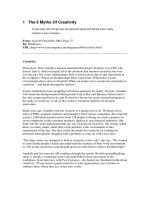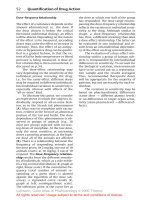6 9chemistry of colour
Bạn đang xem bản rút gọn của tài liệu. Xem và tải ngay bản đầy đủ của tài liệu tại đây (120.42 KB, 7 trang )
6.9 Chemistry of Colour
Recapping from earlier
• Coloured substances absorb radiation in the
visible region of the EM spectrum.
• Absorb energy - outermost electrons
promoted to excited state.
• Same electrons involved in bonding or lone
pairs.
• Innermost electrons more tightly held by
attraction to the nucleus - more energy
needed for excitation.
Pulling theory together
• Some transitions
needing less energy
are brought about by
visible light
• Excitation energy is
greater when UV light
is absorbed.
• Compounds absorbing
UV radiation appear
colourless.
Coloured organic compounds
• Often contain unsaturated groups, -C=O,
-C=C, -N=N• Usually part of extended delocalised
electron system called the chromophore.
• Electrons in double bonds more spread out require less energy to excite than those in
single bonds particularly in conjugated
system.
• Absorption of radiation in visible region.
Groups, energy and colour
• -OH, -NH2 , or NR2 attached to chromophores to enhance or
modify the colours.
• Lone pair electrons become involved in the delocalised
system.
• Small changes change the energy of light absorbed and
therefore the colour.
• Dyes often different colours in acids and alkalis - useful
indicators.
• Methyl orange bond to H+ at pH 3.5 and below - red, above
pH3.5 there is no H+ bonded and the dye is yellow.
Coloured inorganic compounds
• Often contain transition metals.
• Ligands cause 5 d orbitals to split into two
levels
• Energy needed to excite to a higher level
depends on the oxidation state of the metal
and the type of ligand.
• Redox reactions often accompanied by
colour changes.
• Changing a ligand in a complex can change the
colour - different ligands have different splitting
powers.
• Electrons can move from the ground state in one
atom to the excited state in another atom electron transfer. Often bright colours, Chrome
yellow and Prussian blue.









